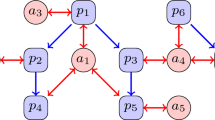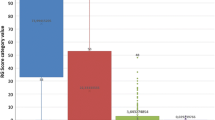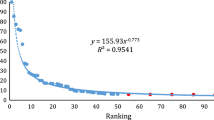Abstract
The notions of reputation and popularity in academia are critical for taking decisions on research grants, faculty position tenure, and research excellence awards. These notions are almost always associated with the publication track records of researchers. Thus, it is important to assess publication track records quantitatively. To quantify publication records, bibliographic indices are usually adopted and, among these, citation-based indices such as the H-index are frequently considered. In this paper we study the correlation between P-score, a publication record index and H-index, a very popular citation-based index, in the setting of conference ranking. While H-indices reflect the popularity of a given publication or researcher in academia, P-scores can reflect the reputation of a publication or researcher among its peers, considering a reference set of reputable researchers. Popularity and reputation are frequently considered to be equivalent properties in the formulation of citation based indices, however these properties are not identical. Indeed, we first show that H-indices and P-scores are correlated with a Kendall-Tau coefficient that exceeds 0.5. However, we also notice that they show important differences. Particularly, we identify publication venues with high H-indices and low P-scores, as well as venues with low H-indices and high P-scores. We provide interpretations for these findings and discuss how they can be used by research funding councils and committees to better support their funding decisions.







Similar content being viewed by others
Notes
According to Google Scholar, up to the end of 2017.
While our data set is entirely composed of Computer Science conferences, nothing in our method is particular to this field. That is, our index is applicable to any field of knowledge.
References
Babić, D., Kutlača, Đ., Živković, L., Štrbac, D., & Semenčenko, D. (2016). Evaluation of the quality of scientific performance of the selected countries of southeast europe. Scientometrics, 106(1), 405–434.
Baeza-Yates, R., & Ribeiro-Neto, B. (2011). Modern information retrieval: The concepts and technology behind search (2nd ed.). Boston: Addison-Wesley Publishing Company.
Balaban, A. T. (2012). Positive and negative aspects of citation indices and journal impact factors. Scientometrics, 92(2), 241–247.
Bar-Ilan, J. (2008). Which h-index?—A comparison of WoS, Scopus and Google Scholar. Scientometrics, 74(2), 257–271.
Benevenuto, F., Laender, A. H., & Alves, B. L. (2016). The H-index paradox: Your coauthors have a higher H-index than you do. Scientometrics, 106(1), 469–474.
Bollen, J., Rodriquez, M. A., & Van de Sompel, H. (2006). Journal status. Scientometrics, 69(3), 669–687.
Bornmann, L., & Daniel, H. D. (2005). Does the h-index for ranking of scientists really work? Scientometrics, 65(3), 391–392.
Bornmann, L., & Marx, W. (2011). The h-index as a research performance indicator. European Science Editing, 37(3), 77–80.
Braun, T., Glänzel, W., & Schubert, A. (2006). A Hirsch-type index for journals. Scientometrics, 69(1), 169–173.
Brin, S., & Page, L. (1998). The anatomy of a large scale hypertextual Web search engine. Computer Networks and ISDN Systems, 30(1–7), 107–117.
Chen, J., & Konstan, J. A. (2010). Conference paper selectivity and impact. Communications of the ACM, 53(6), 79–83.
Ding, Y., & Cronin, B. (2011). Popular and/or prestigious? Measures of scholarly esteem. Information Processing and Management, 47(1), 80–96.
Egghe, L. (2006). Theory and practise of the g-index. Scientometrics, 69(1), 131–152.
Egghe, L. (2008). The influence of transformations on the h-index and the g-index. Journal of the American Society for Information Science and Technology, 59(8), 1304–1312.
Garfield, E. (1955). Citation indexes for science. Science, 122(3159), 108–111.
Gonçalves, G. D., Figueiredo, F., Almeida, J. M., & Gonçalves, M. A. (2014). Characterizing scholar popularity: A case study in the computer science research community. In Proceedings of the 14th ACM/IEEE-CS joint conference on digital libraries (pp. 57–66).
Hirsch, J. E. (2005). An index to quantify an individual’s scientific research output. Proceedings of the National Academy of Sciences, 102(46), 16569–16572.
Hirsch, J. E. (2007). Does the h index have predictive power? Proceedings of the National Academy of Sciences, 104(49), 19193–19198.
Järvelin, K., & Kekäläinen, J. (2002). Cumulated gain-based evaluation of IR techniques. ACM Transactions on Information Systems, 20(4), 422–446.
Kellner, A. W. A., & Ponciano, L. C. M. O. (2008). H-index in the Brazilian academy of sciences—Comments and concerns. Anais da Academia Brasileira de Ciências, 80(4), 771–781.
Kendall, M. G. (1955). Rank correlation methods (2nd ed.). New York: Hafner Publishing Company.
Langville, A. N., & Meyer, C. D. (2006). Google’s pagerank and beyond: The science of search engine rankings. Princeton: Princeton University Press.
Lee, D. H. (2019). Predictive power of conference-related factors on citation rates of conference papers. Scientometrics, 118(1), 281–304. https://doi.org/10.1007/s11192-018-2943-z.
Leydesdorff, L. (2009). How are new citation-based journal indicators adding to the bibliometric toolbox? Journal of the American Society for Information Science and Technology, 60(7), 1327–1336.
Leydesdorff, L., Zhou, P., & Bornmann, L. (2013). How can journal impact factors be normalized across fields of science? An assessment in terms of percentile ranks and fractional counts. Journal of the American Society for Information Science and Technology, 64(1), 96–107.
Martins, W. S., Gonçalves, M. A., Laender, A. H., & Pappa, G. L. (2009). Learning to assess the quality of scientific conferences: A case study in computer science. In Proceedings of the 9th ACM/IEEE-CS joint conference on digital libraries (pp. 193–202).
Meyer, C. (1989). Stochastic complementation, uncoupling Markov chains, and the theory of nearly reducible systems. SIAM Review, 31(2), 240–272.
Nane, T. (2015). Time to first citation estimation in the presence of additional information. In Proceedings of the 15th international society of scientometrics and informetrics conference (pp. 249–260).
Nature (2016). Time to remodel the journal impact factor. Nature 535(7613), 466.
Nelakuditi, S., Gray, C., & Choudhury, R. R. (2011). Snap judgement of publication quality: How to convince a dean that you are a good researcher. ACM SIGMOBILE Mobile Computing and Communications Review, 15(2), 20–23.
Newman, M. (2010). Networks: An introduction. Oxford: Oxford University Press.
Pinski, G., & Narin, F. (1976). Citation influence for journal aggregates of scientific publications: Theory, with application to the literature of physics. Information Processing and Management, 12(5), 297–312.
Piwowar, H. A. (2013). Value all research products. Nature, 493(7431), 159.
Ribas, S., Ribeiro-Neto, B., de Souza e Silva, E., Ueda, A. H., & Ziviani, N. (2015a). Using reference groups to assess academic productivity in computer science. In Proceedings of the 24th international conference on world wide web, WWW ’15 companion (pp. 603–608). New York, NY, USA: ACM.
Ribas, S., Ribeiro-Neto, B., Santos, R. L., de Souza e Silva, E., Ueda, A., & Ziviani, N. (2015b). Random walks on the reputation graph. In Proceedings of the 2015 international conference on the theory of information retrieval, ICTIR ’15 (pp. 181–190). New York, NY, USA: ACM.
Riikonen, P., & Vihinen, M. (2008). National research contributions: A case study on Finnish biomedical research. Scientometrics, 77(2), 207–222.
Rossner, M., Van Epps, H., & Hill, E. (2007). Show me the data. The Journal of Cell Biology, 179(6), 1091–1092.
Saha, S., Saint, S., & Christakis, D. A. (2003). Impact factor: A valid measure of journal quality? Journal of the Medical Library Association, 91(1), 42–46.
Sun, Y., & Giles, C. L. (2007). Popularity weighted ranking for academic digital libraries. In Proceedings of the 29th European conference on IR research, ECIR’07 (pp. 605–612). Berlin: Springer.
Wainer, J., Eckmann, M., Goldenstein, S., & Rocha, A. (2013). How productivity and impact differ across computer science subareas. Communications of the ACM, 56(8), 67–73.
Waltman, L., & Eck, N. (2013). Source normalized indicators of citation impact: An overview of different approaches and an empirical comparison. Scientometrics, 96(3), 699–716.
Wendl, M. C. (2007). H-index: However ranked, citations need context. Nature, 449(7161), 403.
Yan, E., Ding, Y., & Sugimoto, C. R. (2011). P-rank: An indicator measuring prestige in heterogeneous scholarly networks. Journal of the American Society for Information Science and Technology, 62(3), 467–477.
Author information
Authors and Affiliations
Corresponding author
Ethics declarations
Conflict of interest
The authors declare that they have no conflict of interest.
Rights and permissions
About this article
Cite this article
de Freitas Veneroso, J.M., Dias, M., Ueda, A. et al. P-score: a reputation bibliographic index that complements citation counts. Scientometrics 121, 1269–1291 (2019). https://doi.org/10.1007/s11192-019-03247-0
Received:
Published:
Issue Date:
DOI: https://doi.org/10.1007/s11192-019-03247-0




